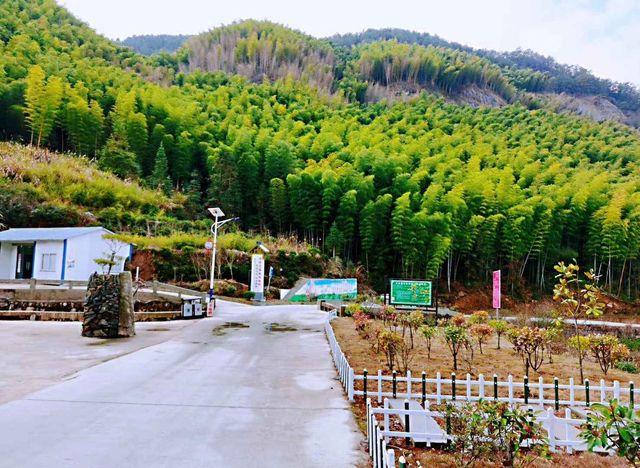Xuejiagang Site: Where History Meets Nature in Stunning Landscapes

An Essential Guide to Visiting Xuejiagang Site
Nestled in the heart of Qianshan County in Anhui Province, the Xuejiagang Site (薛家岗遗址) is a remarkable treasure trove of ancient history, offering a window into the Neolithic past of China. Renowned as the birthplace of the unique Xuejiagang Culture, this archaeological site is the only one of its kind in Anhui and serves as a pivotal chapter in the narrative of early Chinese civilization.
As you wander through this historic landscape, you’ll find that the remnants of ancient habitation tell stories of a people who thrived in harmony with their environment. From intricately crafted pottery to sophisticated stone tools, the artifacts unearthed here offer profound insights into the daily lives, artistic expressions, and cultural practices of our ancestors.
The site is not only a feast for history enthusiasts but also a serene escape for travelers seeking to connect with nature and the echoes of the past. With its picturesque surroundings and rich cultural heritage, Xuejiagang provides a perfect backdrop for exploration and reflection. Whether you’re a seasoned archaeologist or simply curious about the world, this site beckons you to delve into its mysteries and discover the narratives that shaped the region.
Visiting Xuejiagang is more than just a trip; it’s an immersive experience that deepens your understanding of Chinese heritage and the enduring legacy of human creativity and resilience. Prepare to be captivated by the stories etched in stone and clay, and let the spirit of Xuejiagang inspire your journey.
In This Guide
- An Essential Guide to Visiting Xuejiagang Site
- The Rich History and Legends of Xuejiagang Site
- Main Highlights: What You Absolutely Can’t Miss
- Planning Your Visit: A Practical Guide
- Tickets: Prices, Booking, and Tips
- How to Get There: A Complete Transportation Guide
- Local Cuisine and Accommodation Nearby
- Frequently Asked Questions
- Final Thoughts on Your Trip
The Rich History and Legends of Xuejiagang Site
Nestled in the picturesque Qianshan County of Anhui Province, the Xuejiagang Site (薛家岗遗址) stands as a testament to the rich tapestry of China’s Neolithic era. This archaeological marvel is not just a collection of ancient relics; it is a gateway into the origins of the Xuejiagang Culture, which is the only Neolithic culture identified in Anhui province. The site dates back to around 5000 to 3000 BCE and has become an essential marker in understanding the evolution of early human settlements along the Yangtze River.
Excavations at Xuejiagang have unearthed an impressive array of artifacts, including intricately crafted pottery and stone tools that showcase the advanced skills of its ancient inhabitants. Among these discoveries are unique pottery balls, adorned with geometric shapes and inscriptions, which are rare finds in China. The craftsmanship displayed in the various artifacts, such as flat pots and duckbilled tanks, illustrates a sophisticated understanding of material culture that was prevalent during the Neolithic period.
The site is not only significant for its tangible relics but also for its connection to the cultural heritage of the region. The Xuejiagang Culture represents a distinct developmental sequence that sets it apart from neighboring archaeological sites. This uniqueness has captured the attention of historians and archaeologists alike, allowing for a deeper exploration of the connections between the cultures of the Yangtze River basin and those of the Yellow River. The findings from Xuejiagang provide invaluable insights into the social structures, economic practices, and artistic expressions of early Chinese civilization.
Moreover, the site is steeped in legend, notably associated with the ancient narrative poem “Peacocks Flying Southward,” which is recognized as the first long narrative poem in Chinese literature. This literary masterpiece not only reflects the political and social life of the time but also offers a glimpse into the customs and conditions of women in ancient society. The connection of this poem to the Xuejiagang Site enhances its cultural significance, marking it as a site of both historical and literary importance.
As you wander through the remnants of this ancient settlement, you are not merely observing artifacts; you are stepping into a narrative that has shaped the cultural identity of Anhui Province for millennia. The Xuejiagang Site stands as a proud representative of the ingenuity and resilience of those who came before us, inviting travelers to connect with the profound history that lingers in the air and echoes through the artifacts left behind.

Xuejiagang Site.
Main Highlights: What You Absolutely Can’t Miss
Visiting the Xuejiagang Site is like stepping back in time to the Neolithic era, offering international travelers a unique glimpse into one of China’s most significant archaeological treasures. Here are the main highlights you absolutely can’t miss during your visit:
Unearth the Xuejiagang Culture
The Xuejiagang Site is renowned for being the cradle of the Xuejiagang Culture, the only Neolithic culture identified in Anhui Province. Archaeological excavations have revealed a wealth of artifacts, including finely crafted pottery and tools. As you wander through the site, take the time to appreciate the intricacies of the artifacts, such as the exquisite pottery decorated with geometric shapes and character carvings, which are rare finds in China.
Explore the Archaeological Riches
This site holds the distinction of being the most abundant Neolithic site in Anhui. As you explore, keep an eye out for production tools and living utensils that reflect the daily lives of the people who inhabited this area thousands of years ago. Notable discoveries include stone knives with unique hole patterns and a variety of pottery forms like duckbilled tanks and flat basins, showcasing the advanced craftsmanship of the time.
Admire the Cliffside Stone Inscriptions
A visit to the nearby Cliffside stone inscriptions is a must. Spanning over 1,200 years, these inscriptions encapsulate the artistic evolution of Chinese calligraphy and sculpture. Dating from the Tang dynasty to contemporary times, the inscriptions reflect the cultural richness and historical significance of the area, making it a living museum of literature and art.
Visit the Sanzu Temple
The Sanzu Temple, a significant religious site within the Xuejiagang area, is not only an architectural marvel but also a window into the spiritual life of the region. This temple has a profound historical narrative tied to the rise and fall of local religious practices. As you explore its grounds, you’ll gain insight into the cultural and religious evolution that has taken place here over centuries.
Experience the Scenic Surroundings
The Xuejiagang Site is nestled in the picturesque landscapes of Qianshan County. While here, take a moment to soak in the natural beauty that surrounds the site. The granite peaks and lush greenery create a stunning backdrop for your exploration, making it a perfect spot for photography and reflection on the intertwining stories of nature and history.
Engage with Local Culture
Finally, don’t miss the opportunity to engage with the local culture and traditions. The area surrounding Xuejiagang is rich in folklore, particularly the narrative poem “Peacocks Flying Southward,” which holds significant cultural importance. Learning about this tale will deepen your understanding of the local customs and the historical context of the region.
Whether you’re an archaeology enthusiast or a casual traveler, the Xuejiagang Site promises an enriching experience that connects you to China’s ancient past. Make sure to allocate 1-2 hours for your visit to fully immerse yourself in the history and culture of this remarkable location.

Xuejiagang Site.
Planning Your Visit: A Practical Guide
Visiting the Xuejiagang Site offers a unique glimpse into ancient Chinese culture, particularly the Neolithic Xuejiagang culture, which holds significant archaeological and historical value. To ensure an enriching experience at this remarkable site, here’s a practical guide to help you plan your visit effectively.
Getting There
Xuejiagang Site is located in Qianshan County, Anhui Province, near Anqing City. The exact address is Nanyue Road, Qianshan County, Anqing City, Anhui, China. The site is accessible by various modes of transportation:
- By Air: The nearest major airport is Anqing Tianzhushan Airport. From the airport, you can take a taxi or arrange for a car rental to reach the site.
- By Train: Anqing Railway Station is the closest train station. From there, you can take a taxi or a local bus to reach Xuejiagang.
- By Bus or Car: If you are driving, Qianshan is well-connected by road, and you can use navigation apps to find the best route to the site.
Opening Hours and Tickets
The Xuejiagang Site is generally open for visitors, but it’s essential to check specific opening hours before your visit as they may vary seasonally or due to local events. The recommended visit duration is about 1 to 2 hours, which provides ample time to explore the site and take in its historical significance.
Ticket prices may vary, so it’s wise to check for the latest pricing information online or contact the site directly prior to your visit. It’s also a good idea to look for any available promotions or discounts.
When to Visit
The best time to visit Xuejiagang is during the spring (April to June) or autumn (September to November) months. During these periods, the weather is generally mild, making it comfortable for exploring outdoor sites. Summer can be hot and humid, while winter may experience colder temperatures.
What to Expect
While at the Xuejiagang Site, you will encounter:
- Archaeological Relics: Explore the remnants of the Neolithic culture, including pottery, stone tools, and other artifacts that tell the story of life in ancient China.
- Cultural Insights: Learn about the significance of the Xuejiagang culture, which is recognized as the only Neolithic culture in Anhui province. The site offers a unique perspective on the early civilizations along the Yangtze River.
- Educational Exhibits: Engage with informative displays and exhibits that delve into the history and significance of the site. These resources enhance your understanding of the archaeological findings.
Nearby Attractions
Consider extending your visit to explore nearby attractions, such as:
- Tianzhushan Scenic Area: Renowned for its natural beauty, granite peaks, and cultural significance, this UNESCO World Heritage site is a short distance away.
- Sanzu Temple: A significant religious site that reflects the rich spiritual heritage of the region.
- Peacock Southeast Flying Scenic Spot: An area known for its scenic views and recreational opportunities.
Travel Tips
- Dress Comfortably: Wear comfortable clothing and sturdy shoes, as you may be walking on uneven terrain while exploring the site.
- Stay Hydrated: Bring water, especially during warmer months, to keep yourself hydrated.
- Respect the Site: As you explore, remember to respect the archaeological integrity of the site and adhere to any posted guidelines.
Conclusion
A visit to the Xuejiagang Site is not just a journey through history; it’s an opportunity to connect with the roots of Chinese culture. By following this guide, you can ensure a smooth and insightful experience as you delve into the fascinating world of ancient civilizations. Safe travels!

Xuejiagang Site.
Tickets: Prices, Booking, and Tips
When planning your visit to the Xuejiagang Site, also known as the Xuejiagang Cultural Sites, here are some essential details regarding ticket prices, booking options, and tips for making the most of your experience.
Ticket Prices
As of 2025, entrance to the Xuejiagang Cultural Sites is generally affordable, with ticket prices averaging around RMB 30 (approximately $5 USD). This modest fee grants you access to one of the most significant Neolithic archaeological sites in Anhui Province, where you can explore the rich cultural heritage of the region.
Booking Your Tickets
Tickets can conveniently be purchased on-site. However, to avoid any last-minute hassles, especially during peak tourist seasons, it is advisable to pre-book your tickets online through various travel platforms such as Trip.com. This way, you can ensure your entry and potentially take advantage of any available discounts or promotional offers.
Opening Hours
The Xuejiagang Cultural Sites typically welcome visitors daily; however, it’s important to confirm specific opening hours closer to your visit date as they may vary. A recommended visit duration is between 1 to 2 hours, allowing you ample time to explore the site and appreciate its historical significance.
Tips for Visiting
- Plan Your Visit: To fully enjoy the site, consider visiting in the morning or late afternoon when the weather is cooler, and the light is perfect for photography.
- Guided Tours: If you’re keen on deeper insights into the site’s history and archaeology, consider joining a guided tour. Local guides can provide valuable context that enhances your understanding of the Xuejiagang Culture.
- Explore Nearby Attractions: The area surrounding the Xuejiagang Site boasts additional cultural sites and natural beauty. Make a day of it by exploring nearby attractions such as the Tianzhushan Mountain Scenic Area or Sanzu Temple.
- Accessibility: Ensure you check for any accessibility information if you have specific mobility needs. The site is generally accommodating, but it’s good to verify in advance.
Conclusion
Embarking on a journey to the Xuejiagang Site offers a unique glimpse into ancient Chinese civilization and its archaeological treasures. With affordable entry prices, straightforward booking options, and a wealth of nearby attractions, your visit promises to be both enriching and enjoyable. Don’t forget to immerse yourself in the local culture and history as you explore this fascinating site!
How to Get There: A Complete Transportation Guide
Reaching the Xuejiagang Site in Qianshan County, Anhui, is an adventure that combines modern convenience with a touch of cultural exploration. This Neolithic archaeological site, which significantly contributes to our understanding of ancient Chinese civilization, is accessible through various modes of transport. Here’s a comprehensive guide on how to get there.
By Air
The nearest major airport to Xuejiagang Site is Anqing Tianzhushan Airport (AQG), located approximately 40 kilometers (about 25 miles) away. This airport services domestic flights, primarily from cities like Beijing, Shanghai, and Guangzhou.
- From the Airport to Xuejiagang: Upon arrival, you can take a taxi or pre-arranged transfer to reach the site. The journey should take around 50 minutes to an hour.
By Train
If you prefer traveling by train, Anqing Railway Station is your main destination. This station is well-connected with several major cities, including Hefei, Nanjing, and Wuhan.
- Getting to Xuejiagang from Anqing Railway Station: After disembarking, you can take a taxi directly to the site, which is about 30 kilometers (18 miles) away. Alternatively, you can opt for a local bus to Qianshan County and then a taxi from there, making the total journey about 45 minutes to an hour.
By Bus
Local buses serve as a reliable means of transportation for budget-conscious travelers. Buses from major cities and towns in Anhui often travel to Qianshan County.
-
Bus Services: You can catch a bus from Anqing Bus Station to Qianshan County. This journey typically takes about one hour.
-
Final Leg to Xuejiagang: Once you arrive at the Qianshan County bus station, you can take a taxi or, depending on the proximity, walk to the Xuejiagang Site, which is only a short distance away.
By Car
For those who enjoy driving, renting a car can provide the flexibility to explore the scenic routes around Anhui Province. The site is well-marked, and a GPS will guide you along the routes.
- Driving Directions: From Anqing, take the G50 Huyu Expressway, then switch to the S102 provincial road, which will lead you directly to Nanyue Road in Qianshan County, where the site is located.
Local Transportation
Once in Qianshan County, local taxis and ride-hailing services like Didi are available for easy navigation to the site. Given the relatively small size of the area, distances are manageable.
Tips for Travelers
- Language: While some signs may have English translations, it’s advisable to have the name of the site written in Chinese (薛家岗遗址) to show to taxi drivers.
- Weather Considerations: Check the local weather forecast for Qianshan County before your visit to ensure a comfortable experience.
- Cultural Respect: As a site of historical significance, ensure to respect the local customs and regulations during your visit.
With this guide, you’re all set to embark on your journey to the remarkable Xuejiagang Site, where ancient history comes alive amidst the beautiful landscapes of Anhui Province.

Xuejiagang Site.
Local Cuisine and Accommodation Nearby
When visiting the Xuejiagang Site, immersing yourself in the local culture and cuisine is a must. This archaeological treasure in Qianshan County offers not only a glimpse into ancient civilization but also a chance to savor the traditional flavors of Anhui Province.
Local Cuisine
Anhui cuisine, known as one of China’s Eight Culinary Traditions, is characterized by its emphasis on fresh ingredients and unique cooking techniques. As you explore the area around Xuejiagang, be sure to try these local dishes:
- Stewed Soft-Shelled Turtle: A local delicacy, this dish is known for its rich flavor and tender texture, often cooked with medicinal herbs.
- Bamboo Shoots with Pork: This dish combines the crispness of fresh bamboo shoots with savory pork, creating a delightful balance of flavors.
- Braised Fish Head with Tofu: A comforting dish that highlights the region’s freshwater fish, served in a savory sauce with silky tofu.
- Dried Bamboo Shoots: A popular snack in the area, these are often seasoned and served as a side dish, showcasing the local agricultural bounty.
For an authentic dining experience, consider visiting a local restaurant or food stall. Many establishments pride themselves on using fresh, locally sourced ingredients that reflect the rich culinary heritage of the region.
Accommodation Nearby
After a day of exploration, rest your head at one of the comfortable accommodations near the Xuejiagang Site. Here are some recommendations:
-
Qianshan Hotel: Located conveniently close to the Xuejiagang Site, this hotel offers modern amenities and comfortable rooms. Guests can enjoy a peaceful atmosphere and easy access to local attractions.
-
Anhui Qianshan International Hotel: A bit more upscale, this hotel features spacious rooms, a restaurant serving local cuisine, and facilities for business travelers. It’s a great choice for those seeking comfort and convenience.
-
Guesthouses and Homestays: For a more intimate experience, consider staying at a local guesthouse or homestay. These options often provide a chance to interact with local families and experience their hospitality firsthand.
Choosing to dine and stay in the vicinity of the Xuejiagang Site enriches your travel experience, allowing you to savor local flavors while resting in comfort after your adventures. Whether you’re indulging in traditional dishes or relaxing in cozy accommodations, your visit to this historical site promises to be memorable.

Xuejiagang Site.
Frequently Asked Questions
-
What are the opening hours of the Xuejiagang Site?
The Xuejiagang Site typically welcomes visitors throughout the week, but it’s advisable to confirm specific opening hours before your visit. This information can often change, so checking online or contacting the site directly is recommended. -
How much time should I allocate for my visit?
Plan to spend about 1 to 2 hours exploring the Xuejiagang Site. This should give you enough time to appreciate the historical significance, take in the scenic beauty, and enjoy any exhibits or informational displays. -
What is the best way to reach the Xuejiagang Site?
The site is located in Qianshan County, Anqing City, Anhui Province. You can reach it by taxi or local transportation from nearby cities. If you’re driving, there are parking facilities available. -
Are there any entry fees for visiting the site?
Yes, there is typically an entry fee to access the Xuejiagang Site. Prices can vary depending on the season or any ongoing promotions, so it’s a good idea to check ahead for current pricing. -
Can I take photographs at the site?
Visitors generally are allowed to take photographs at the Xuejiagang Site. However, be respectful of any signs indicating restricted areas, and consider the local customs regarding photography, particularly in sensitive or sacred locations. -
Is there any guided tour available?
Yes, guided tours may be available at the Xuejiagang Site. These tours often provide valuable insights into the history and significance of the site, making your visit more enriching. Check in advance to see if you need to book a tour or if there are on-the-spot guides available. -
What should I wear when visiting the site?
Wear comfortable clothing and sturdy shoes, especially if you plan to walk around the site or explore its various areas. The terrain may vary, so it’s best to be prepared for both paved paths and natural ground. -
Are there any facilities available on site, such as restrooms or refreshments?
Basic facilities such as restrooms may be available at the Xuejiagang Site. However, options for refreshments might be limited, so it’s a good idea to bring water and snacks, especially if you plan to spend an extended time exploring the area.
Final Thoughts on Your Trip
As you wrap up your journey through the captivating Xuejiagang Site, take a moment to reflect on the profound connection to ancient civilizations that this remarkable location offers. Nestled in the serene landscapes of Qianshan County, the site is not just a window into the Neolithic era but a vibrant testament to humanity’s enduring quest for knowledge and culture. The artifacts unearthed here, from intricately crafted pottery to the unique Xuejiagang Culture, tell stories of resilience, creativity, and the rich tapestry of life along the Yangtze River.
Allow the echoes of the past to resonate within you as you walk among the remnants of a time long gone, where the artistry and ingenuity of early inhabitants come alive. This site is not just about history; it’s a celebration of heritage that continues to inspire. Whether you are an avid history buff, a cultural enthusiast, or simply a curious traveler, Xuejiagang invites you to immerse yourself in its narrative, leaving you with a deeper appreciation for the roots of civilization.
As you prepare to depart, carry with you the stories and lessons of Xuejiagang, and let them inform your understanding of our shared human experience. This journey into the past is a reminder that we are all part of a larger story—one that continues to unfold in the landscapes we traverse.